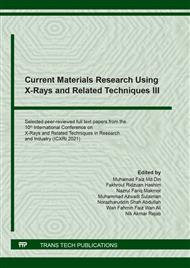[1]
C. Yang, Z. Gong, M. Serhan, G., Koivu, Z. Yang, B. Hollebone, P. Lambert and C.E. Brown, Characterization of naphthenic acids in crude oils and refined petroleum products, Fuel. 255 (2019) 1-10.
DOI: 10.1016/j.fuel.2019.115849
Google Scholar
[2]
C. Wu, A.D. Visscher, and I.D. Gates, Naphthenic acids removal from crude oil and oil sands process-affected water, Fuel. 253 (2019)1229-1246.
DOI: 10.1016/j.fuel.2019.05.091
Google Scholar
[3]
J.G. Speight, High acid crudes. first ed., Elsevier, Oxford, (2014).
Google Scholar
[4]
N.M. Shukri, J. Jaafar, W.A.W.A. Bakar, and Z.A. Majid, Characterization and deacidification of acidic petroleum crude oil utilizing metal oxide catalyst supported on alumina and ammoniated polyethylene glycol solution, Malays. J. Anal. Sci. 21 (2017) 830–838.
DOI: 10.17576/mjas-2017-2104-09
Google Scholar
[5]
F.V. Adams, C.E. Chukwuneke, and O.B. Agboola, Recent techniques for the removal of naphthenic acid from heavy crude oils. In processing of heavy crude oils - Challenges and opportunities, IntechOpen., London, 2019, pp.199-206.
DOI: 10.5772/intechopen.89585
Google Scholar
[6]
B.S. Rana, D.W. Cho, K. H. Cho, and J.N. Kim,Total acid number (TAN) reduction of high acidic crude oil by catalytic esterification of naphthenic acids in fixed-bed continuous flow reactor, Fuel. 231 (2018) 271-280.
DOI: 10.1016/j.fuel.2018.05.074
Google Scholar
[7]
J.Y. Park, F. Zafar, C.H. Kim, J.M. Choi, and J.W. Bae, Synergy effects of basic graphitic-C3N4 over acidic Al2O3 for a liquid-phase decarboxylation of naphthenic acids, Fuel Process. Technol. 184 (2019) 36-44.
DOI: 10.1016/j.fuproc.2018.11.001
Google Scholar
[8]
N.M. Shukri, J. Jaafar, W.A.W.A. Bakar, and Z.A. Majid, Removal of naphthenic acids from high acidity Korean crude oil utilizing catalytic deacidification method, J. Ind. Eng. Chem. 28 (2015) 110–116.
DOI: 10.1016/j.jiec.2015.02.005
Google Scholar
[9]
J.L. Ayastuy, E. Fernandez-Puertas, M.P. Gonzalez-Marcos, and M.A. Gutierrez-Ortiz, Transition metal promoters in CuO/CeO2 catalysts for CO removal from hydrogen streams. Int. J. Hydrog. Energy. 37 (2012) 7385 –7397.
DOI: 10.1016/j.ijhydene.2012.02.007
Google Scholar
[10]
N.M. Shukri, J. Jaafar, W.A.W.A. Bakar, and Z.A. Majid, Optimization of basic catalyst with ammoniated polyethylene glycol for the removal of naphthenic acid from petroleum crude oil by Box – Behnken design, Clean Technol. Environ. Policy. 17 (2015) 2387–2400.
DOI: 10.1007/s10098-015-0981-2
Google Scholar
[11]
A.S. Al-Fatesh, A.H. Fakeehaa, A.A. Ibrahim, W.U. Khan, H. Atia, R. Eckelt, Decomposition of methane over alumina supported Fe and Ni–Fe bimetallic catalyst: Effect of preparation procedure and calcination temperature, J. Saudi Chem. Soc. 22 (2018) 239-247.
DOI: 10.1016/j.jscs.2016.05.001
Google Scholar
[12]
N.A.M. Shohaimi, N.S.M. Halim, N.M. Shukri, and N.H. Abdullah, Catalytic study of Ni/Ce/ Al2O3 and Ni/Ca/Al2O3 on the removal of naphthenic acid from petroleum crude oil utilizing sodium thiocyanate in ethanol, Pet. Sci. Technol. 38 (2020) 602-608.
DOI: 10.1080/10916466.2020.1770282
Google Scholar
[13]
Y. Yu, J. Zhang, C. Chen, C. He, J. Miao, H. Li, and J. Chen, Effects of calcination temperature on physicochemical property and activity of CuSO4/TiO2 ammonia-selective catalytic reduction catalysts, J. Environ. Sci. 91 (2020) 237-245.
DOI: 10.1016/j.jes.2020.01.010
Google Scholar
[14]
A.A. Ibrahim, A.S. Al-Fatesh, N.S. Kumar, A.E. Abasaeed, S.O. Kasim and A.H. Fakeeha, Dry Reforming of Methane Using Ce-modified Ni Supported on 8%PO4 + ZrO2 Catalysts, Catalysts. 10 (2020) 1-16.
DOI: 10.3390/catal10020242
Google Scholar


